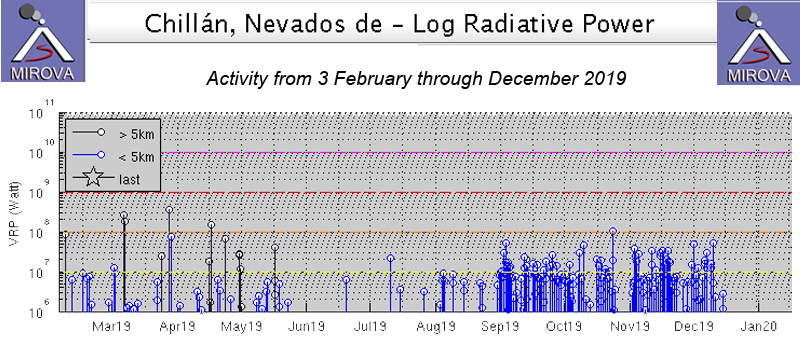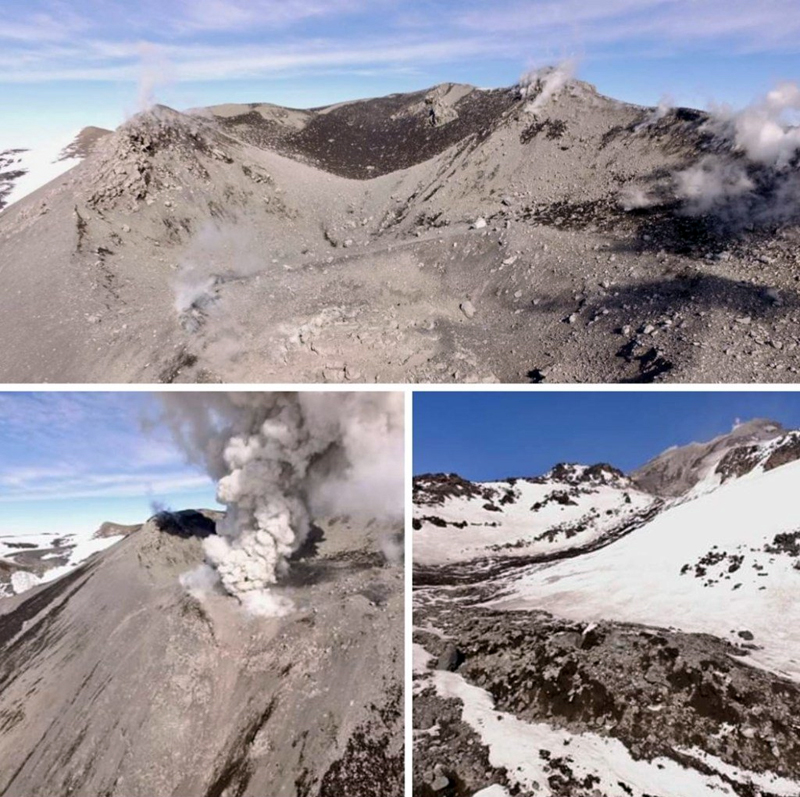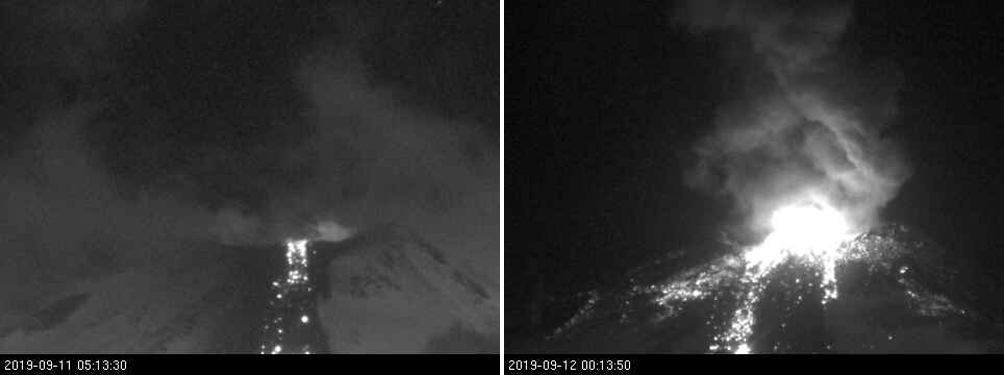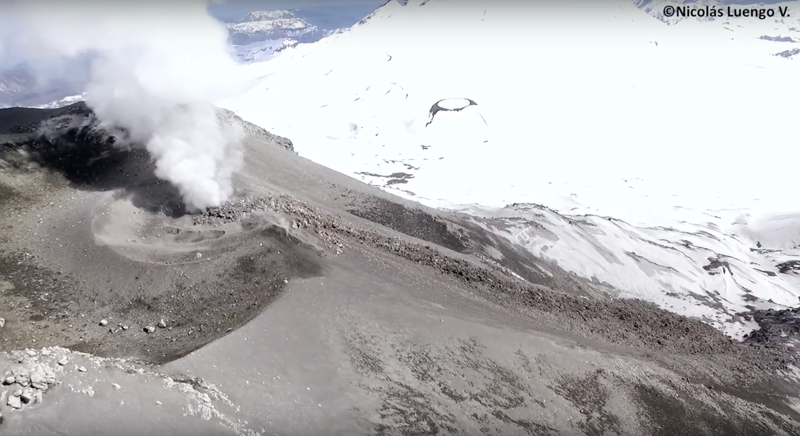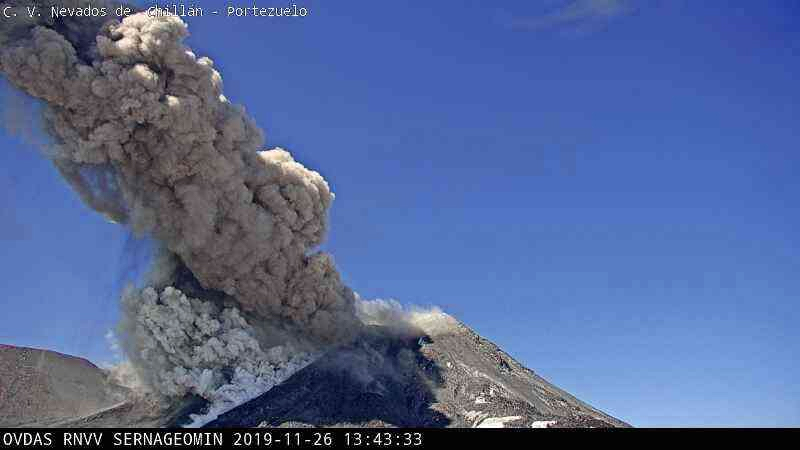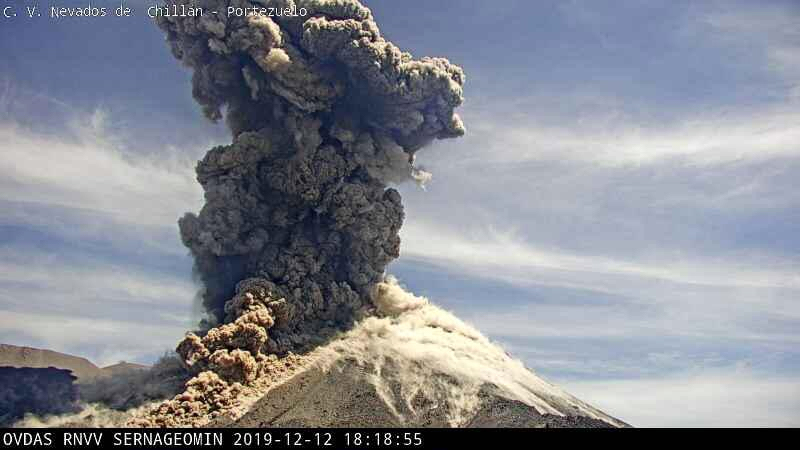Report on Nevados de Chillan (Chile) — January 2020
Bulletin of the Global Volcanism Network, vol. 45, no. 1 (January 2020)
Managing Editor: Edward Venzke.
Edited by A. Elizabeth Crafford.
Nevados de Chillan (Chile) Many explosions, ash plumes, lava and pyroclastic flows June-December 2019
Please cite this report as:
Global Volcanism Program, 2020. Report on Nevados de Chillan (Chile) (Crafford, A.E., and Venzke, E., eds.). Bulletin of the Global Volcanism Network, 45:1. Smithsonian Institution. https://doi.org/10.5479/si.GVP.BGVN202001-357070
Nevados de Chillan
Chile
36.868°S, 71.378°W; summit elev. 3180 m
All times are local (unless otherwise noted)
Nevados de Chillán is a complex of late-Pleistocene to Holocene stratovolcanoes in the Chilean Central Andes. An eruption started with a phreatic explosion and ash emission on 8 January 2016 from a new crater (Nicanor) on the E flank of the Nuevo crater, which lies on the NW flank of the cone of the large stratovolcano referred to as Volcán Viejo. Strombolian explosions and ash emissions continued throughout 2016 and 2017; a lava dome within the Nicanor crater was confirmed in early January 2018. Explosions and pyroclastic flows continued during 2018 and the first half of 2019. This report covers continuing activity from June-December 2019 when ongoing explosive events produced ash plumes, lava, and pyroclastic flows. Information for this report is provided primarily by Chile's Servicio Nacional de Geología y Minería (SERNAGEOMIN)-Observatorio Volcanológico de Los Andes del Sur (OVDAS), and by the Buenos Aires Volcanic Ash Advisory Center (VAAC).
Nevados de Chillán was relatively quiet during June 2019, generating only a small number of explosions with ash plumes. This activity continued during July; some events produced incandescent ejecta around the crater. By August a distinct increase in activity was noticeable; ash plumes were larger and more frequent, and incandescent ejecta rose hundreds of meters above the summit a number of times. Frequent explosions were typical during September; the first of several blocky lava flows emerged from the crater mid-month. Inflation that began in mid-July continued with several centimeters of both horizontal and vertical displacement. By October, pyroclastic flows often accompanied the explosive events in addition to the ash plumes, and multiple vents opened within the crater. Three more lava flows had appeared by mid-November; explosions continued at a high rate. Activity remained high at the beginning of December but dropped abruptly mid-month. MODVOLC measured three thermal alerts in September, two in October, seven in November, and six in December. This period of increased thermal activity closely matches the thermal anomaly data reported by the MIROVA project (figure 37), which included an increase at the end of August 2019 that lasted through mid-December before stopping abruptly. Several lava flows and frequent explosions with incandescent ejecta and pyroclastic flows were reported throughout the period of increased thermal activity.
Activity during June-August 2019. Nevados de Chillán remained relatively quiet during June 2019 with a few explosions of ash. At the active Nicanor crater, located on the E flank of the Volcán Nuevo dome, predominantly white steam plumes were observed daily in the nearby webcams. The growth rate of the dome inside the crater was reported by SERNAGEOMIN as continuing at about 260 m3/day. They noted an explosion on 3 June; the Buenos Aires VAAC reported a puff of ash seen from the webcam drifting SE at 3.7 km altitude (figure 38). The webcam indicated sporadic weak emissions continuing that day and the next. Minor explosions were also reported on 7-8 June and included incandescence observed at night and ejecta deposited around the crater rim. The Buenos Aires VAAC reported a narrow ash plume drifting ENE in multispectral imagery under clear skies late on 7 June. The webcams showed sporadic emissions of ash at 3.4 km altitude on 19 June that dissipated rapidly.
Minor pulsating explosive activity continued during July 2019 with multiple occurrences of ash emissions. Ash emissions rose to 3.7 km altitude on 4 July and were seen in the SERNAGEOMIN webcam; the VAAC reported an emission on 8 July that rose to 4.3 km altitude and drifted SE. Monitoring stations near the complex recorded an explosive event early on 9 July; incandescence with gases and ejecta were deposited around the crater and an ash plume rose to 3.9 km and drifted SE. Small ash plumes from sporadic puffs on 12 July rose to 4.6 km altitude. An explosive event on 14 July also produced incandescent ejecta around the crater along with weak sporadic ash emissions. Single ash emissions on 18 (figure 39) and 22 July at 3.7 km altitude drifted ESE from summit before dissipating; another emission on 26 July was reported at 4.3 km altitude.
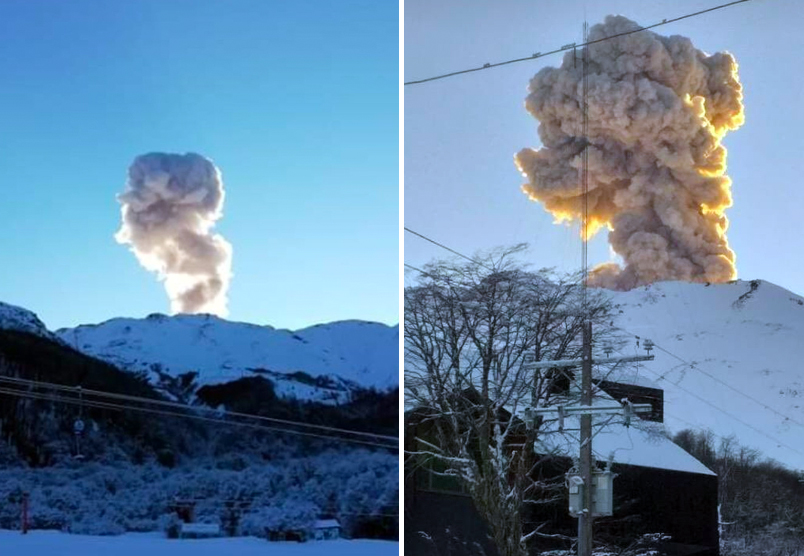 |
Figure 39. Local news sources reported ash emissions at Nevados de Chillán on 18 July 2019. Courtesy of INF0SCHILE (left) and Radio Ñuble (right). |
A distinct increase in the intensity and frequency of explosive activity was recorded during August 2019. SERNAGEOMIN noted ash emissions and explosions during 3-4 August in addition to the persistent steam plumes above the Nicanor crater (figure 40). The Buenos Aires VAAC reported a single puff on 3 August that was seen in the webcam rising to 3.9 km altitude and dissipating quickly. The next day a pilot reported an ash plume estimated at 5.5 km altitude drifting E. It was later detected in satellite imagery; the webcam revealed continuous emission of steam and gas with intermittent puffs of ash. SERNAGEOMIN issued a special report (REAV) on 6 August noting the increase in size and frequency of explosions, some of which produced dense ash plumes that rose 1.6 km above the crater along with incandescent ejecta. They also reported that satellite imagery indicated a 1.5-km-long lahar that traveled down the NNE flank as a result of the interaction of the explosive ejecta with the snowfall near the summit.
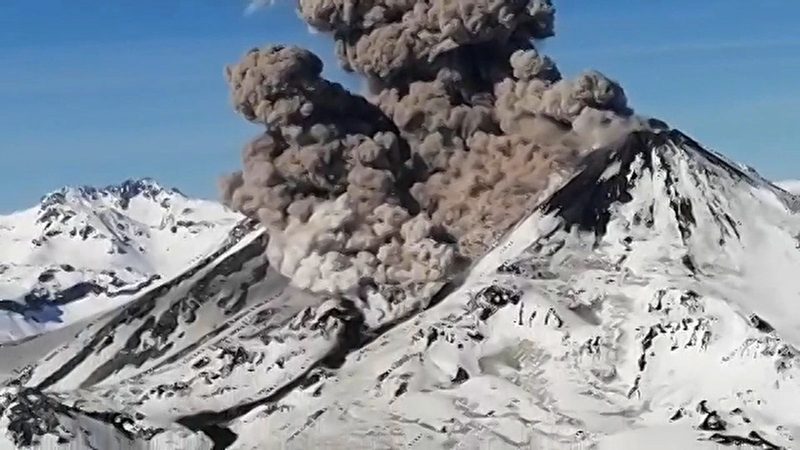 |
Figure 40. Climbers captured video of a significant explosion at Nevados de Chillán on 4 August 2019. Courtesy of CHV Noticias. |
Beginning on 9-10 August 2019, and continuing throughout the month, SERNAGEOMIN observed explosive nighttime activity with incandescent ejecta scattered around the crater rim along with moderate levels of seismicity each day. A diffuse ash plume was detected in satellite imagery by the VAAC on 9 August drifting NW at 4.9 km altitude. SERNAGEOMIN issued a new warning on 12-13 August that the recent increase in activity since the end of July suggested the injection of a new magmatic body that could lead to larger explosive events with pyroclastic and lava flows. They reported pyroclastic ejecta from multiple explosions on 13 August rising 765 and 735 m above the crater. Drone images taken between 4 and 12 August showed the destruction of the summit dome from multiple explosions with the Nicanor Crater (figure 41). The VAAC reported sporadic pulses of volcanic ash drifting N during 12-14 August, visible in satellite imagery estimated at 4.3 km altitude. By 17-18 August, they noted constant steam emissions interspersed with gray plumes during explosive activity.
An increase in seismicity, especially VT events, during 21-22 August 2019 resulted in multiple special REAV reports from SERNAGEOMIN. They noted on 21 August that an explosion produced gas emissions and pyroclastic material that rose 1,400 m above the crater; the next day material rose 450 m. That night, in addition to incandescent ejecta around the crater, they reported small high-temperature flows on the N flank which extended to the NNE flank a few days later. The VAAC reported pulses of ash plumes moving SE on 22 August at 4.3 km altitude. A faint ash cloud was visible in satellite imagery on 29 August drifting E at 3.7 km altitude (figure 42). The cloud was dissipating rapidly as it moved away from the summit. Sporadic ash emissions from intermittent explosions continued moving ESE then N and NE; they were reported daily through 5 September. They continued to rise in altitude to 3.9 km on 30 August, 4.3 km on 1 September, and 4.6 km on 3 September.
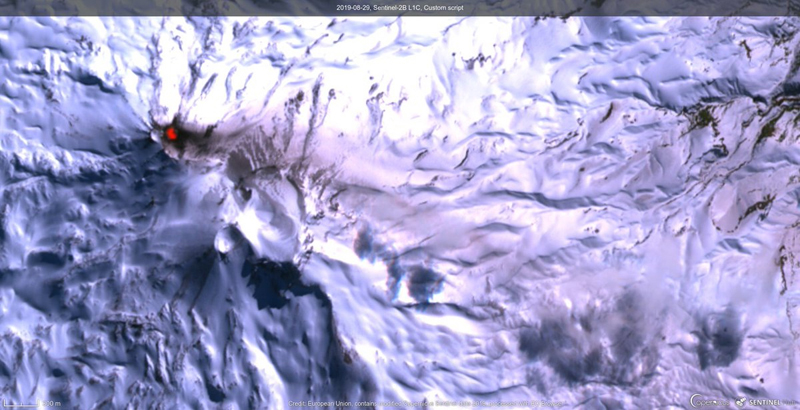 |
Figure 42. Incandescence at the summit of Nevados de Chillán and ashfall covering snow to the E was captured in Sentinel-2 satellite imagery on 29 August 2019. Courtesy of Copernicus EMS. |
Activity during September-October 2019. Frequent explosions from Nicanor crater continued during September 2019, producing numerous ash plumes and small high-temperature flows along the NNE flank. A webcam detected a small lateral vent on the NNE flank about 50 m from the crater rim emitting gas and particulates on 2-3 September. Multiple explosions during 3-5 September were associated with gas and ash emissions and incandescent ejecta deposited around the crater rim (figure 43). The network of GNSS stations recording deformation of the volcanic complex confirmed on 3-4 September that inflation, which had been recorded since mid-July 2019, was continuing at a rate of about 1 cm/month. Blocks of incandescent ejecta from numerous explosions were observed rolling down the N flank on 6-7 September and the E flank the following night.
SERNAGEOMIN reported on 9-10 September that satellite imagery revealed a new surface deposit about 130 m long trending NNE from the center of crater. They reported an increase in the level of seismicity from moderate to high on 10-11 September and observed incandescent ejecta at the summit during several explosions (figure 44). During a flyover on 12 September scientists confirmed the presence of a new blocky lava flow emerging from Nicanor Crater and moving down the NNE flank of Nuevo volcano. The flow was about 600 m long, 100 m wide, and 5 m thick with a blocky surface and incandescent lava at the base within the active crater. Measurements with a thermal camera indicated a temperature around 800°C within the active crater, and greater than 100°C on the surface of the flow. Frequent high-energy explosions that day produced incandescent ejecta that could be seen from Las Trancas and Shangri-La (figure 45). Ashfall 0.5 cm thick was reported 2 km from the volcano to the SW. The flow was visible from the webcam located N of Nicanor on 16-17 September. Satellite imagery indicated the flow was about 550 m long and moving at a rate of about 21 m/day.
During 18-22 September 2019 multiple special reports of seismicity were released each day with incandescent ejecta, gas, and particulate emissions often observed at the summit crater; the lava flow remained active. On 24 September ashfall was reported about 15 km NW in communities including Las Trancas; small pyroclastic flows were observed the following day. Horizontal inflation of 2.4 cm was reported on 25 September, and vertical inflation was measured at 3.4 cm since mid-July. SERNAGEOMIN noted that while the frequency of explosions had increased, the energy released had decreased. Morphological changes in Nicanor crater suggested that it was growing at its SW edge and eroding the adjacent Arrau crater; the NE edge of the crater was unstable.
Plumes of steam and ash continued along with the explosions for the remainder of the month. During the night, incandescent ejecta was observed, and the low-velocity lava flow continued to move. Multiple VAAC reports were issued virtually every day of September. Pulses of ash were moving SE at 4.3 km altitude on 7-8 September. For most of the rest of the month sporadic emissions with minor amounts of ash were observed in either the webcam or satellite images at an altitude of 3.7 km, occasionally rising to 4.3 km. They drifted generally SE but varied somewhat with the changing winds. Continuous ash emissions were observed during 24-25 September that rose as high as 4.9 km altitude and drifted E, clearly visible in satellite imagery. After that, the altitude dropped back to 3.7 km and the plume was only faintly and intermittently visible in satellite imagery.
Low-altitude gray ash plumes were observed rising from Nicanor crater almost every day that weather permitted during October 2019. Incandescent ejecta was frequently observed at night. Beginning on 6-7 October, SERNAGEOM reported pyroclastic flows traveling short distances from the crater most days. They traveled 1.13 km down the NNE flank, 0.42 km down the NNW flank and 0.88 km down the SW flank. The blocky lava flow on the NNE flank was no longer active (figure 46). During 9-12 October, multiple special reports of increased seismic activity (REAVs) were issued each day. Inflation continued throughout the month. On 10 October the total horizontal deformation (since mid-July) was 3 cm, with a rate of movement a little over 1 cm/month; the total vertical displacement was 4.5 cm, with a rate of 1.93 cm/month during the previous 30 days.
In a special report issued on 11 October, SERNAGEOMIN mentioned that analysis of satellite imagery indicated a new emission center within the Nicanor crater adjacent to the dome vent active since December 2017 and to the lava flow of September. The new center was oval shaped with an E-W dimension of 60 m and a N-S dimension of 55 m, located about 90 m SE of the old, still active center, and was the site of the explosive activity reported since 30 September.
On 16 October a new blocky flow was observed on the NE flank of the Nicanor Crater; it was about 70 m long, moving about 30 m/day. By 21 October it had reached 130 m in length, and its rate of advance had slowed significantly. Beginning on 25 October seismicity decreased noticeably and much less surface activity was observed at the crater. Explosions at the end of the month produced steam plumes, gas emissions and minor pulsating ash emissions.
The Buenos Aires VAAC reported a puff of ash at 4.9 km altitude on 1 October moving SE. Continuous emission of steam and gas with sporadic puffs of ash that rose to around 3.7-4.3 km altitude were typical every day after that until 25 October usually drifting S or E; they were most often visible in the webcams, and occasionally visible in satellite imagery when weather conditions permitted. A diffuse plume of ash was detected on 16 October drifting SE at 4.6 km altitude. The VAAC reported incandescence visible at the summit in webcam images on 22 October; a significant daytime explosion on 24 October produced a large incandescent ash cloud (figure 47). The next day the VAAC detected weak pulses of ash plumes in satellite images extending E from the summit for 130 km. Intermittent ash emissions were reported drifting SE at 3.7-4.3 km each day from 29-31 October.
Activity during November-December 2019. Moderate seismicity continued during November 2019 with recurrent episodes of pulsating gas and ash emissions. Incandescent ejecta was visible many nights that the weather conditions were favorable (figure 48). In the Daily Report (RAV) issued on 6 November, SERNAGEOMIN noted that the original 700-m-long blocky lava flow on the NNE flank active during September had been partly covered by another flow, about 350 m long. They also reported that pyroclastic density currents were observed in the area immediately around the crater extending in several directions. They extended 850 m down the SW flank, 670 m down the NW flank, 1,680 m down the N flank, and 440 m to the NNE.
Changes in the crater area indicated a growth of the SW edge of the Nicanor Crater, continuing to erode the Arrau crater, with the constant emission of gas, ash, and incandescent ejecta that produced plumes up to 1.8 km high. SERNAGEOMIN also observed activity from a vent at the NE edge of the crater that included gas emission and ejecta, but no lava flow. The fourth lava flow observed in recent months (L4) was identified on the NNE slope on 13 November adjacent to the earlier flows; it was about 70 m long and slowly advancing. By 19 November L4 consisted of two lobes and extended about 90 m from the edge of the Nicanor crater advancing at an average rate of 0.4 m/hour. The vent producing L4 was located about 60 m SSE of the vent that produced the earlier flows (L1, L2, and L3). By 28 November the flow had reached a length of 165 m and was no longer advancing. A series of explosions reported on 25-27 and 30 November produced ejecta that rose 800, 1,000, 1,300, and 700 m above the crater.
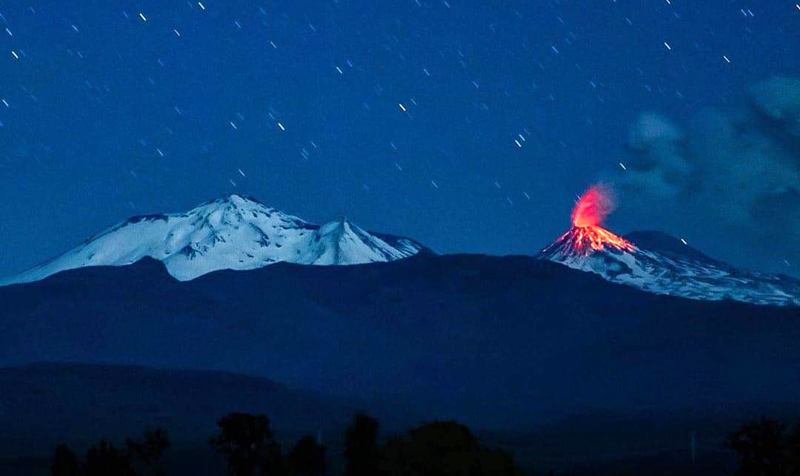 |
Figure 48. Incandescent ejecta at Nevados de Chillán was clearly visible at night on 3 November 2019. Courtesy of Claudio Kanisius. |
Ash emissions were reported by the Buenos Aires VAAC during most of November, usually visible from the webcams, but often also seen in satellite imagery. The plumes generally reached 3.7-4.6 km altitude and drifted SSE. They usually occurred as continuous emission of steam and gas accompanied by sporadic pulses of ash but were sometimes continuous ash for several hours. They were visible about 100 km E of the summit on 2 November, and over 200 km SE the following day. A narrow plume of ash was seen in visual satellite imagery extending 50 km E of the summit on 9 November. Intermittent incandescence at the summit was seen from the webcam on 18 November. Pulses of ash were detected in satellite imagery extending 125 km SE on 22 November. Strong puffs of ash briefly rose to 4.9 km altitude and drifted NE on 26 November (figure 49); incandescence during the nighttime was visible in the webcam on 28 November.
Pulsating emissions of gas and ejecta continued into December 2019. Five explosions were reported on 1 December that produced gas plumes which rose 300-800 m above the crater. Three more explosions occurred on 3 December sending gas plumes 500-1,000 m high. SERNAGEOMIN reported on 4 December that explosive activity was observed from four vents within the Nicanor crater. This activity triggered new pyroclastic flows that extended 1,100 m E and 400 m S. By 5 December the total vertical inflation reported since July was 8 cm. A large explosion on 5 December sent material 1.6 km above the summit and pyroclastic flows down the flanks (figure 50). The webcams at Andarivel and Portezuelo showed a pyroclastic flow moving 400 m W, a direction not previously observed; this was followed by additional pyroclastic flows to the N and E.
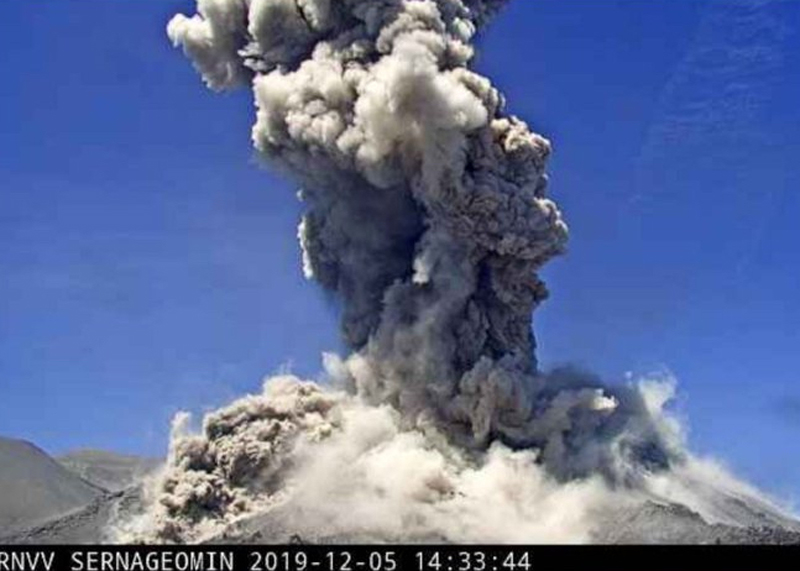 |
Figure 50. A large explosion at Nevados de Chillán on 5 December 2019 produced an ash plume that rose 1.6 km above the summit and sent pyroclastic flows down the flanks. Courtesy of SERNAGEOMIN. |
On 9 December SERNAGEOMIN noted that the increase to four active vents was causing erosion on the S and SE edges of the crater making the most affected areas to the SW, S, SE and E of the crater. Major explosions reported that day produced pyroclastic flows that descended down the E and ESE flanks and particulate emissions that rose 1 km. The SW flank near the crater was also affected by ejecta and pyroclastic debris carried by the wind. The most extensive pyroclastic flows travelled down the E flank for the next several days; explosions on 10 December sent material 1.2 km high. Three explosions were noted on 11 December; the first sent incandescence close to 200 m high, and the second produced a column of particulate material 1.2 km high. The first of two explosions on 12 December sent material 1.8 km above the crater and pyroclastic flows down the flanks (figure 51). Although explosions were reported on 13 and 14 December, cloudy skies prevented observations of the summit.
Intermittent ash emissions were reported by the Buenos Aires VAAC during 1-13 December 2019. They rose to 3.7-4.3 km and drifted generally E. Pulses of ash were detected at 4.9 km altitude moving S in satellite imagery on 9 December. The last reported ash emission for December was on the afternoon of 12 December; puffs of ash could be seen in satellite imagery moving E at 4.6 km altitude. A decrease in particulate emissions and explosions was reported beginning on 14 December, and no further explosions were recorded by infrasound devices after 15 December. The deposits from the earlier pyroclastic flows had reached 600 m E and 300 m W of the crater. Seismic activity was recorded as low instead of moderate beginning on 25 December. A total horizontal inflation of about 6 cm since July was measured at the end of December.
Geological Summary. The compound volcano of Nevados de Chillán is one of the most active of the Central Andes. Three late-Pleistocene to Holocene stratovolcanoes were constructed along a NNW-SSE line within three nested Pleistocene calderas, which produced ignimbrite sheets extending more than 100 km into the Central Depression of Chile. The dominantly andesitic Cerro Blanco (Volcán Nevado) stratovolcano is located at the NW end of the massif. Volcán Viejo (Volcán Chillán), which was the main active vent during the 17th-19th centuries, occupies the SE end. The Volcán Nuevo lava-dome complex formed during 1906-1945 on the NW flank of Viejo. The Volcán Arrau dome complex was then constructed on the SE side of Volcán Nuevo between 1973 and 1986, and eventually exceeded its height. Smaller domes or cones are present in the 5-km valley between the two major edifices.
Information Contacts: Servicio Nacional de Geología y Minería (SERNAGEOMIN), Observatorio Volcanológico de Los Andes del Sur (OVDAS), Avda Sta María No. 0104, Santiago, Chile (URL: http://www.sernageomin.cl/), Twitter: @Sernageomin; Hawai'i Institute of Geophysics and Planetology (HIGP) - MODVOLC Thermal Alerts System, School of Ocean and Earth Science and Technology (SOEST), Univ. of Hawai'i, 2525 Correa Road, Honolulu, HI 96822, USA (URL: http://modis.higp.hawaii.edu/); MIROVA (Middle InfraRed Observation of Volcanic Activity), a collaborative project between the Universities of Turin and Florence (Italy) supported by the Centre for Volcanic Risk of the Italian Civil Protection Department (URL: http://www.mirovaweb.it/); Cristian Farias Vega, Departamento de Obras Civiles y Geología, Universidad Católica de Temuco, Vilcún, Región de La Araucanía, Chile (URL: https://twitter.com/cfariasvega/status/1187471827255226370); Copernicus Emergency Management Service (Copernicus EMS), Joint Research Centre, European Union (URL: https://emergency.copernicus.eu/, https://twitter.com/CopernicusEMS/status/1168156474817818624); Volcanes de Chile, Proyectos de la Fundación Volcanes de Chile, Chile (URL: https://www.volcanesdechile.net/, https://twitter.com/volcanesdechile/status/1199496839491395585); Pehuenia Online, Pehuenia, Argentina (URL: http://pehueniaonline.com.ar/, https://twitter.com/PehueniaOnline/status/1135703309824745472); Eco Bio Bio La Red Informativa, Bio Bio Region, Chile (URL: http://emergenciasbiobio.blogspot.com/, https://twitter.com/Eco_BioBio_II/status/1141734238590574593); INF0SCHILE (URL: https://twitter.com/INF0SCHILE/status/1151849611482599425); Radio Ñuble AM y FM, Chillán, Chile (URL: http://radionuble.cl/linea/, lhttps://twitter.com/RadioNuble/status/1151858189299781632); CHV Noticias, Santiago, Chile (URL: https://www.chvnoticias.cl/, https://twitter.com/CHVNoticias/status/1159263718015819777); Movisis.org Internacional, Manabi, Ecuador (URL: https://movisis.org/, https://twitter.com/MOVISISEC/status/1160778823031558144); Carlos Bustos (URL: https://twitter.com/cbusca1970/status/1168932243873644548); EarthQuakesTime (URL: https://twitter.com/EarthQuakesTime/status/1171654504841908229); Red Geocientifica de Chile (URL: https://twitter.com/RedGeoChile/status/1171972482875703296); American Earthquakes (URL: https://twitter.com/earthquakevt/status/1172271139760091136); PatoArias, Talca, Chile (URL: https://twitter.com/patoarias/status/1172287142191665153); Volcanologia Chile, (URL: http://www.volcanochile.com/joomla30/, https://twitter.com/volcanologiachl/status/1182707451554078720); Claudio Kanisius (URL: https://twitter.com/ClaudioKanisius/status/1191182878346031104).


